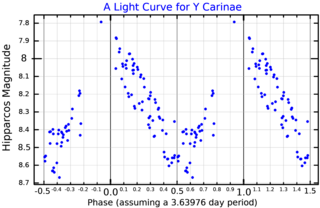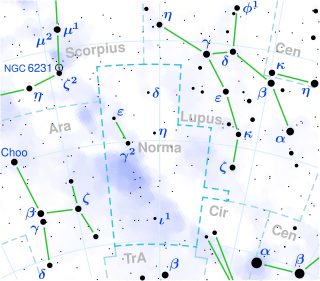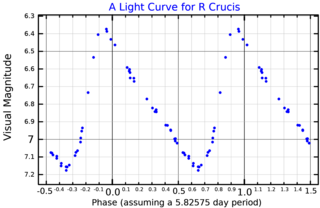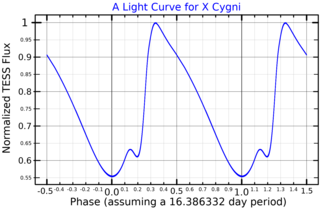
RR Lyrae variables are periodic variable stars, commonly found in globular clusters. They are used as standard candles to measure (extra) galactic distances, assisting with the cosmic distance ladder. This class is named after the prototype and brightest example, RR Lyrae.

Eta Aquilae is the Bayer designation for a multiple star in the equatorial constellation of Aquila, the eagle. It was once part of the former constellation Antinous. On average, this star has an apparent visual magnitude of 3.87, making it one of the brighter members of Aquila. Based upon parallax measurements made during the Hipparcos mission, this star is located at a distance of roughly 1,382 light-years, although the parallax estimate has a 44% margin of error.

W Sagittarii is a multiple star system star in the constellation Sagittarius, and a Cepheid variable star.

RT Aurigae is a yellow supergiant variable star in the constellation Auriga, about 1,500 light years from Earth.

Y Carinae is a Classical Cepheid variable, a type of variable star, in the constellation Carina. Its apparent magnitude varies from 7.53 to 8.48.

S Normae is a yellow supergiant variable star in the constellation Norma. It is the brightest member of the open cluster NGC 6087.

FF Aquilae is a classical Cepheid variable star located in the constellation Aquila. It ranges from apparent magnitude 5.18 to 5.51 over a period of 4.470848 days, meaning it is faintly visible to the unaided eye in rural or suburban settings.

TT Aquilae is a Classical Cepheid variable star in the constellation Aquila.

Type II Cepheids are variable stars which pulsate with periods typically between 1 and 50 days. They are population II stars: old, typically metal-poor, low mass objects.

Classical Cepheids are a type of Cepheid variable star. They are young, population I variable stars that exhibit regular radial pulsations with periods of a few days to a few weeks and visual amplitudes ranging from a few tenths of a magnitude up to about 2 magnitudes. Classical Cepheids are also known as Population I Cepheids, Type I Cepheids, and Delta Cepheid variables.

Kappa Pavonis is a variable star in the constellation Pavo. It is the brightest W Virginis variable in the sky.

R Muscae is a yellow-white hued variable star in the southern constellation of Musca. It has a nominal apparent visual magnitude of 6.31, which is near the lower limit of visibility to the naked eye. The distance to this star, as determined from its annual parallax shift of 1.00 mas, is around 3,260 light years.

S Muscae is a classical (δ) Cepheid variable star in the constellation Musca about 2,600 light years away.

R Crucis is a variable star in the southern constellation of Crux. It has a yellow-white hue and is often too faint to see with the naked eye, having an apparent visual magnitude that fluctuates around 6.89. This object is located at a distance of approximately 1,600 light years from the Sun based on parallax, but it is drifting closer with a radial velocity of −13.5 km/s.

RU Camelopardalis, or RU Cam, is a W Virginis variable in the constellation of Camelopardalis. It is also a Carbon star, which is very unusual for a Cepheid variable.

SZ Tauri is a variable star in the equatorial constellation of Taurus. The brightness of this star varies from an apparent visual magnitude of 6.39 down to 6.69 with a period of 3.149 days, which is near the lower limit of visibility to the naked eye. The distance to this star is approximately 2,070 light years based on parallax measurements. There is some indication this may be a binary system, but the evidence is inconclusive.

VZ Cancri is a variable star in the constellation Cancer, abbreviated VZ Cnc. It varies in brightness with a period of 0.178364 days, from an apparent visual magnitude of 7.18 down to 7.91, which lies below the typical threshold of visibility for the naked eye. The distance to this star is approximately 724 light years based on parallax measurements, and it is receding from the Sun with a radial velocity of 25 km/s.

U Sagittarii is a variable star in the southern constellation of Sagittarius, abbreviated U Sgr. It is a classical Cepheid variable that ranges in brightness from an apparent visual magnitude of 6.28 down to 7.15, with a pulsation period of 6.745226 days. At its brightest, this star is dimly visible to the naked eye. The distance to this star is approximately 2,080 light years based on parallax measurements, and it is drifting further away with a radial velocity of 2 km/s.

X Cygni is a variable star in the northern constellation of Cygnus, abbreviated X Cyg. This is a Delta Cephei variable that ranges in brightness from an apparent visual magnitude of 5.85 down to 6.91 with a period of 16.386332 days. At it brightest, this star is dimly visible to the naked eye. The distance to this star is approximately 628 light years based on parallax measurements. It is drifting further away with a radial velocity of 8.1 km/s. This star is a likely member of the open cluster Ruprecht 173.

SU Cygni is a triple star system in the northern constellation of Cygnus, abbreviated SU Cyg. The primary component of the system is a classical Cepheid variable with a period of 3.8455473 days. The changing luminosity of this star causes the system to vary in brightness from a peak apparent visual magnitude of 6.44 down to magnitude 7.22 over the course of its cycle. The distance to this system is approximately 3,200 light years based on parallax measurements. It is a member of the Turner 9 open cluster of stars.



















